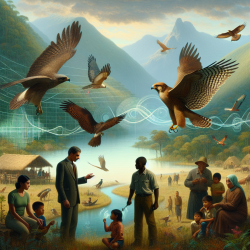Introduction
In the realm of speech-language pathology, understanding the socio-ecological dynamics that influence human interactions is crucial. The study "Human-Wildlife Conflicts in the Southern Yungas: What Role do Raptors Play for Local Settlers?" offers profound insights into the complex relationships between humans and wildlife, particularly focusing on raptors in Northwestern Argentina. This blog aims to highlight key findings from this research and discuss how practitioners can utilize these insights to improve their practice and outcomes for children.
Understanding Human-Wildlife Conflicts
The research conducted in the Southern Yungas region reveals that human-wildlife conflicts (HWC) are deeply rooted in socio-ecological contexts. Specifically, the study identifies that certain high-profile raptor species, particularly those perceived as livestock predators, are at the center of these conflicts. Interestingly, the Andean condor, a vulnerable species, was noted as the most conflictive due to its reputation as a livestock predator.
The study emphasizes the importance of considering the human dimension of conflicts, which includes perceptions, attitudes, and socio-economic contexts. This is a critical takeaway for speech-language pathologists who work with diverse populations, as understanding these human dimensions can lead to more effective communication strategies and interventions.
Applying Research Insights to Practice
For practitioners in speech-language pathology, the following strategies can be derived from the study's findings:
- Emphasize Cultural Competence: Just as the study highlights the importance of understanding local perceptions and socio-economic contexts, speech-language pathologists should prioritize cultural competence in their practice. This involves being aware of and sensitive to the cultural backgrounds and beliefs of the children and families they work with.
- Engage in Interdisciplinary Collaboration: The research underscores the need for transdisciplinary approaches to address conflicts. Similarly, speech-language pathologists can benefit from collaborating with other professionals, such as educators, psychologists, and social workers, to provide holistic care and support for children.
- Utilize Data-Driven Decision Making: The study's reliance on data and interviews to assess human-raptor conflicts serves as a reminder of the importance of data-driven decision-making in speech-language pathology. Practitioners should utilize evidence-based practices and continuously gather data to inform their interventions and track progress.
Encouraging Further Research
The study's findings open the door for further research into the socio-ecological dynamics of human-wildlife conflicts. Speech-language pathologists can contribute to this field by exploring how these dynamics impact communication and social interactions in children. Additionally, practitioners are encouraged to investigate the role of language and communication in shaping perceptions and attitudes towards wildlife and conservation efforts.
Conclusion
By embracing the insights from the study on human-wildlife conflicts in the Southern Yungas, speech-language pathologists can enhance their practice and improve outcomes for children. Understanding the socio-ecological contexts and human dimensions of conflicts can lead to more effective communication strategies and interventions. To read the original research paper, please follow this link: Human-Wildlife Conflicts in the Southern Yungas: What Role do Raptors Play for Local Settlers?










